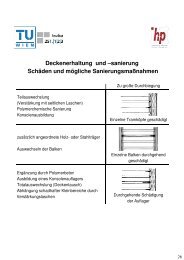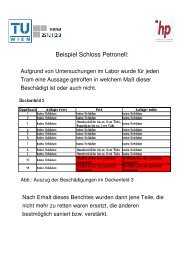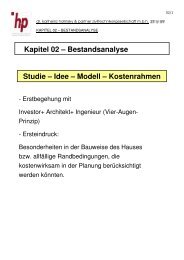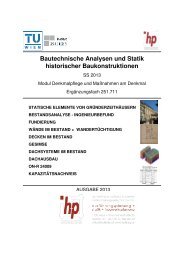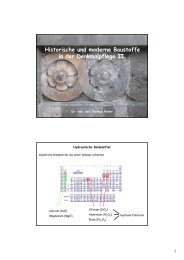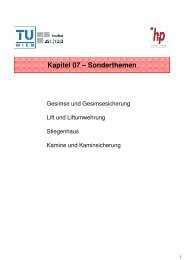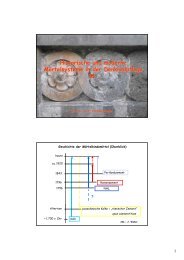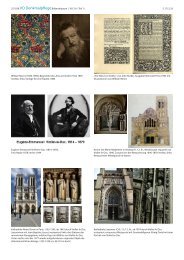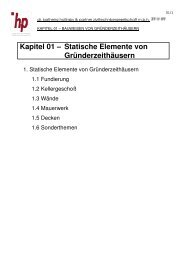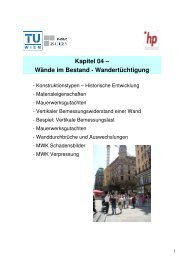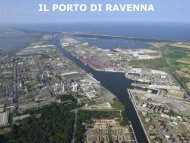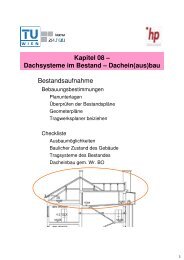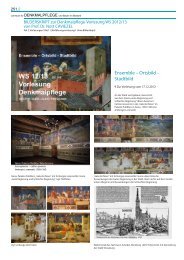Industrial monument preservation in Austria- A survey - Denkmalpflege
Industrial monument preservation in Austria- A survey - Denkmalpflege
Industrial monument preservation in Austria- A survey - Denkmalpflege
Create successful ePaper yourself
Turn your PDF publications into a flip-book with our unique Google optimized e-Paper software.
until 1982. Ultimately, it was the high cost of demolish<strong>in</strong>g the build<strong>in</strong>g, which had already been<br />
condemned, that led to a new utilisation.<br />
Conversion <strong>in</strong>to a luxury hotel admittedly meant the survival of the dom<strong>in</strong>ant appearance on the<br />
banks of the Danube, but additional build<strong>in</strong>gs, the choice of material, surface f<strong>in</strong>ish<strong>in</strong>g and detailed<br />
implementation have robbed the protected Granary of its identity. The value of the build<strong>in</strong>g as an<br />
<strong>in</strong>dustrial <strong>monument</strong> was sacrificed to the requirements of the new use.<br />
That a new utilisation is <strong>in</strong>deed possible while reta<strong>in</strong><strong>in</strong>g the appearance is shown for <strong>in</strong>stance by the<br />
redesign of the New Tobacco Factory <strong>in</strong> Krems-Ste<strong>in</strong> / Lower <strong>Austria</strong>. The factory was constructed<br />
<strong>in</strong> 1922 accord<strong>in</strong>g to plans by the architect Paul Hoppe and rema<strong>in</strong>ed essentially unchanged both<br />
<strong>in</strong>side and outside. The re<strong>in</strong>forced concrete framed structure is characterised by the formal language<br />
of a “third baroque”, and its huge dimensions make it an essential element of the urban silhouette.<br />
The closure of the production facilities <strong>in</strong> the second half of the 1980s led the local council to make<br />
use of the empty premises for the purposes of the Prov<strong>in</strong>cial Scientific Academy. The grid-like<br />
ground plan made conversion easier. Follow<strong>in</strong>g completion of the project <strong>in</strong> 1995, the ma<strong>in</strong><br />
build<strong>in</strong>g with its 15,000 m² floor space has become home to 32 department and sem<strong>in</strong>ar units of<br />
what is now known as the Danube University.<br />
The Himmelreich & Zwicker cloth factory at L<strong>in</strong>z / Upper <strong>Austria</strong> was long threatened by<br />
demolition, and its rescue was an amaz<strong>in</strong>g success. The <strong>in</strong>tegration of a church and parish centre <strong>in</strong><br />
the premises of the former cotton sp<strong>in</strong>n<strong>in</strong>g mill proved to be a spectacular and conv<strong>in</strong>c<strong>in</strong>g reuse of<br />
the <strong>in</strong>dustrial <strong>monument</strong>. The factory was constructed <strong>in</strong> 1908 as a cotton sp<strong>in</strong>n<strong>in</strong>g mill. After it was<br />
closed down, entrepreneurs from Brno and Krnov acquired the site and converted it <strong>in</strong>to a cloth<br />
factory <strong>in</strong> 1934 to 1938. In the 1950s and 1960s, the company, which processed sheep’s wool from<br />
Australia and South America, experienced a second heyday. When the factory was closed <strong>in</strong> 1980,<br />
the property underwent frequent changes of ownership, soon becom<strong>in</strong>g an object of speculation. In<br />
1986, a citizen’s action group succeeded <strong>in</strong> sav<strong>in</strong>g the cloth factory from the threat of demolition. It<br />
was only with considerable difficulty that local politicians and <strong>monument</strong> preservers were only<br />
prevented by a further act of barbarism – similar to the demolition of the L<strong>in</strong>z Woolen Factory three<br />
decades earlier.<br />
Stubborn negotiations f<strong>in</strong>ally led to the renovation and adaptation of the cloth factory <strong>in</strong> the late<br />
1990s accord<strong>in</strong>g to plans by the “L<strong>in</strong>z Architect Group”, who had been the w<strong>in</strong>ners of a<br />
competition for the revitalisation of the cloth factory <strong>in</strong> 1991. The <strong>in</strong>tegration of the church <strong>in</strong> the<br />
former factory is a conv<strong>in</strong>c<strong>in</strong>g and without doubt one of the most remarkable new utilisations <strong>in</strong> the<br />
whole of <strong>Austria</strong>.<br />
It was also possible to prevent the ru<strong>in</strong> of the aero-mechanical laboratory of the Chair for Aerial<br />
Navigation and Automobiles at Vienna University of Technology. The Chair was established <strong>in</strong><br />
1909 under the direction of Professor Richard Koller. The construction of the laboratory <strong>in</strong> 1911/12<br />
was made possible by a generous donation from the <strong>in</strong>dustrialist Arthur Krupp.<br />
The free-stand<strong>in</strong>g pavilion <strong>in</strong> the form of a basilica is broken down <strong>in</strong>to three sections: the threestorey<br />
central build<strong>in</strong>g is flanked by two one-storey w<strong>in</strong>gs each consist<strong>in</strong>g of two rooms. Fully<br />
Institut für Kunstgeschichte, Bauforschung und <strong>Denkmalpflege</strong> | Lehrstuhl für <strong>Denkmalpflege</strong> und Bauen im Bestand<br />
Seite 6 | 7



